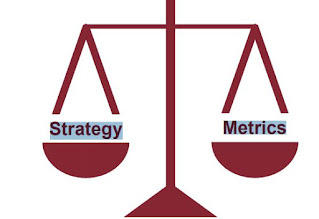17 Key Metrics For Supply Chain Management
- Get link
- X
- Other Apps
Strategy and Metrics
"No matter what strategy is being tracked and measured, meaningful metrics are essential because “you get what you measure"
Perfect Order Measurement
The percentage of orders that are error-free.
((total orders – error orders) / total orders) * 100
This is often broken down by stage:
- Procurement 99.99% perfect
- Production 99.12% perfect
- Transportation 99.02% perfect
- Warehousing 99.98% perfect
The Perfect Order Measure calculates the error-free rate of each stage of a Purchase Order (error in order forecasting for procurement, error in warehouse pickup process, error in invoicing and error in shipping orders etc.).
Cash to Cash Cycle Time
The number of days between paying for materials and getting paid for product.
materials payment date – customer order payment date
- typically averaged for all orders for a week, month, quarter etc..
- many materials are usually required — a weighted average materials payment date can be calculated
Cash to cash measures the amount of time operating capital is tied up. During this time cash is not available for other purposes. A fast cash to cash indicates a lean and profitable supply chain.
Customer Order Cycle Time
Measures how long it takes to deliver a customer order after the purchase order (PO) is received.
actual delivery date – purchase order creation date
A variant of this is the promised customer order cycle time:
requested delivery date – purchase order creation date
Fill Rate
The percentage of a customer’s order that is filled on the first shipment. This can be represented as the percentage of items, SKUs or order value that is included with the first shipment.
(1 – ((total items – shipped items) / total items)) * 100
Fill rate can be important to customer satisfaction and has implications for transportation efficiency.
Supply Chain Cycle Time
The time it would take to fill a customer order if inventory levels were zero.
Sum of the longest lead times for each stage of the cycle
Supply chain cycle time indicates the overall efficiency of the supply chain. Short cycles make for a more efficient and agile supply chain. Analysis of this critical metric can help recognize pain points or competitive advantages.
Inventory Days of Supply
The number of days it would take to run out of supply if it was not replenished.
inventory on hand / average daily usage
SCM seeks to minimize inventory days of supply in order to reduce the risks of excess and obsolete inventory. There are other financial benefits to minimizing this metric — excess inventory tends to tie up operational cash flow.
Read on for more supply chain kpi’s!
Freight bill accuracy
The percentage of freight bills that are error-free.
(error-free freight bills / total freight bills) * 100
Billing accuracy is key to profitability and customer satisfaction.
Freight cost per unit
Usually measured as the cost of freight per item or SKU.
total freight cost / number of items
SCM seeks to minimize freight cost per unit.
Inventory Turnover
The number of times that a company’s inventory cycles per year.
cost of goods sold / average inventory
Another metric that indicates how much inventory is sitting around. A higher inventory turnover indicates an efficient supply chain.
Days Sales Outstanding
A measure of how quickly revenue can be collected from customers.
(Receivables/Sales) * Days in Period
A low days sales outstanding indicates a more efficient business.
Average Payment Period for Production Materials
The average time from receipt of materials and payment for those materials.
(Materials Payables/Total Cost of Materials) * Days in Period
It is in a company’s best interests to pay its suppliers slowly. The longer the average payment period the more efficient the business.
On Time Shipping Rate
The percentage of items, SKUs or order value that arrives on or before the requested ship date.
(Number of On Time Items / Total Items) * 100
The on time shipping rate is key to customer satisfaction. A high rate indicates an efficient supply chain.
Inventory Turnover Ratio (ITR)
ITR helps us to measure the number of times we sell or turn our average inventory kept in the warehouse.
In other words, it measures the number of opportunities to earn profit that we experience each year from our working capital invested in the inventory. It is calculated by dividing Cost of Goods (COGs) sold by the average inventory investment.
ITR: COGs / [(Opening Stock-Closing Stock)/2]
Benchmark:There is no specific benchmark for ITR. However, organizations who are product leaders in the market are likely to satisfy with ITR of 3-4 while operational excellence oriented organizations, such as low-cost airlines or wholesalers aim at achieving 8-9 ITR. On the other hand, distributors that handle a wide range of brands and strive to meet customer needs aim at keeping ITR around 5-7. Deciding the number of ITR is heavily related to the gross margin generated by related SKUs or brands. Thus, managers should also refer to the following KPI.
Turn-Earn Index (TEI)
TEI helps us to combine the gross margin and turnover.
A logic behind TEI is to keep high ITR for SKUs or brands generating low margins and to satisfy with medium- or low-level ITR for SKUs or brands generating high margins.
TEI: (ITR) x (Gross Profit %) x 100
Benchmark:Achieving TEI between 150 and 180 is the best practice in terms of balancing gross margin and inventory. For instance, having 160 TEI for a brand can be interpreted as having 20% margin and turning inventory 8 times or having 40% margin with turning inventory 4 times per year.
Gross Margin Return on Investment (GMROI)
GMROI represents the amount of gross profit earned for every AED (or $, £, €, ₺) of the average investment made in inventory.
It is calculated by dividing gross profit by the average inventory investment. Tracking GMROI on a monthly basis provides a significant clue in terms of having a clear understanding of which SKU or brand produce more gross profit in the inventory.
GMROI: [Gross Profit] / [(Opening Stock-Closing Stock) / 2] X 100
Benchmark: Achieving GMROI between 200 and 225 is the best practice by means of generating gross profit from the inventory hold for the related SKUs or brands.
Days of Supply (DOS)
DOS is the most common KPI used by managers in measuring the efficiency in supply chain.
It is calculated by dividing the average inventory on hand (as value) by the average monthly demand (as value) and then multiplying it by thirty, when measuring on a monthly basis.
DOS: Average Inventory / Monthly Demand x 30
Benchmark: There is no specific target for DOS, but measuring it by considering the following months’ sales forecasts (as value) will help us to have a clear understanding of at which level we need to keep our stock to be able to improve inventory management on a monthly basis. Nevertheless, DOS does not help us to understand how well our inventory will match the demand. To cover this, we need the following KPI.
Inventory Velocity (IV)
IV is the percentage of inventory we are projecting to be consumed within the next period.
It helps the managers to understand how well the inventory on hand matched the demand. It is calculated by dividing the opening stock by the sales forecast of the following period. Tracking IV on a monthly basis will provide significant clues in terms of aligning inventory level to the optimal level for matching supply-demand, and preventing excessive stock in the warehouse.
IV: Opening Stock / Next Month’s Sales Forecast
Benchmark: For continuous SKUs, keeping IV between 60-70% will provide a good match of demand while 75-80% of IV can be more beneficial for fast-moving SKUs. Whilst having IV less than 60% indicates excessive stock, IV over 80% is risky in terms of being out of stock as it calls for Kanban-Pull system.
Practically, not all SKUs or brands can be treated equally via aforementioned KPIs. Applying Pareto Principle will help easily categorize SKUs (e.g. fast-, continuous-, intermittent- and slow-moving SKUs). Categorization can be based on monthly sales volume, margin percentage or the number of exists from the warehouse. Making use of Pareto Principle upon these three perspectives and then taking the average weights will be a good asset in terms of placing each SKU to the correct category.
- Get link
- X
- Other Apps


Comments
Post a Comment